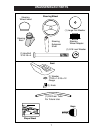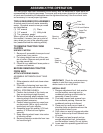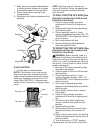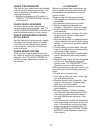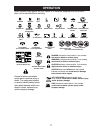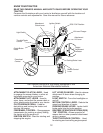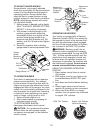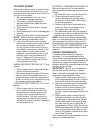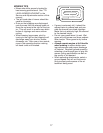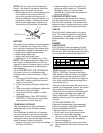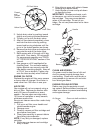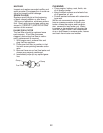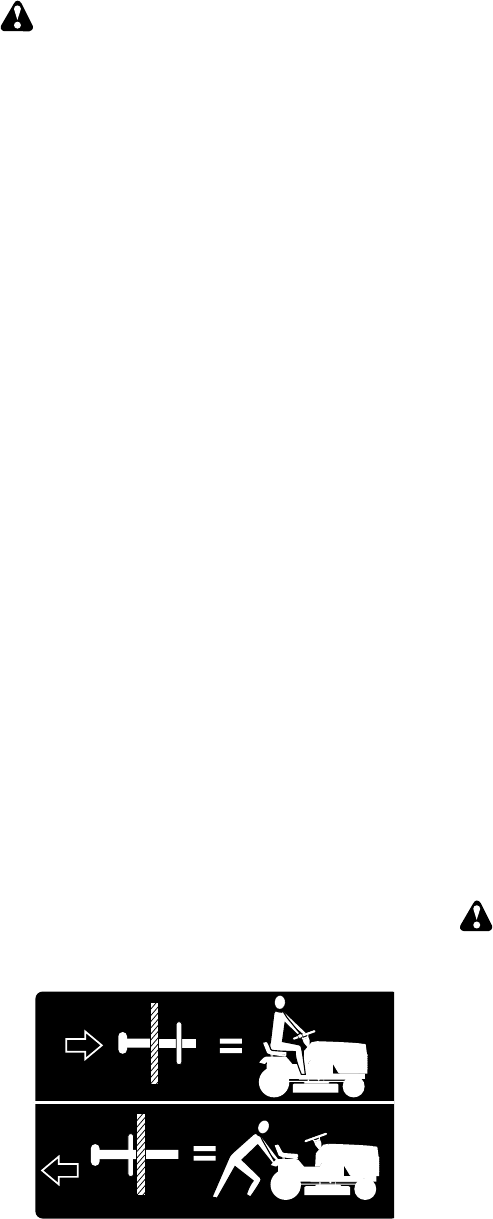
15
ADD GASOLINE
• Fill fuel tank to bottom of tank fi ller neck.
Do not overfi ll. Use fresh, clean, reg u lar
un lead ed gasoline with a min i mum of
87 octane. (Use of leaded gasoline will
increase carbon and lead oxide de pos its
and reduce valve life). Do not mix oil
with gasoline. Purchase fuel in quan ti-
ties that can be used within 30 days to
assure fuel freshness.
CAUTION: Wipe off any spilled oil or
fuel. Do not store, spill or use gas o line
near an open fl ame.
IMPORTANT: When operating in tem per a-
tures below 32°F(0°C), use fresh, clean
win ter grade gas o line to help in sure good
cold weather start ing.
CAUTION: Alcohol blended fuels (called
gasohol or us ing ethanol or methanol) can
attract mois ture which leads to separation
and for ma tion of acids during storage. Acid-
ic gas can damage the fuel system of an
en gine while in storage.
To avoid en gine prob lems, the fuel system
should be emp tied before stor age of 30
days or longer. Drain the gas tank, start
the engine and let it run until the fuel lines
and carburetor are emp ty. Use fresh fuel
next season. See Stor age In struc tions for
additional in for ma tion.
Never use engine or car bu re tor clean er
prod ucts in the fuel tank or per ma nent
dam age may occur.
BEFORE STARTING THE ENGINE
CHECK ENGINE OIL LEVEL
The engine in your tractor has been
shipped, from the factory, already fi lled
with sum mer weight oil.
1. Check engine oil with tractor on level
ground.
2. Remove oil fi ll cap/dipstick and wipe
clean, reinsert the dipstick and screw
cap tight, wait for a few seconds,
remove and read oil level. If nec es sary,
add oil until “FULL” mark on dipstick is
reached. Do not overfi ll.
• For cold weather operation you should
change oil for easier starting ((See the
oil viscosity chart in the Main te nance
sec tion of this manual).
• To change engine oil, see the Main te -
nance section in this manual.
TOWING CARTS AND OTHER AT TACH -
MENTS
Tow only the attachments that are rec om -
mend ed by and comply with spec i fi ca tions
of the manufacturer of your tractor. Use
common sense when tow ing. Too heavy
of a load, while on a slope, is dangerous.
Tires can lose traction with the ground and
cause you to lose control of your tractor.
02219
Transmission Engaged
Transmission Disengaged
NOTE: To protect hood from damage
when transporting your tractor on a truck
or a trailer, be sure hood is closed and
secured to tractor. Use an appropriate
means of tying hood to tractor (rope, cord,
etc.).
TO OPERATE ON HILLS
WARNING: Do not drive up or down
hills with slopes greater than 15° and do
not drive across any slope. Use the slope
guide at the back of this manual.
• Choose the slowest speed before start-
ing up or down hills.
• Avoid stopping or changing speed on
hills.
• If slowing is necessary, move throt tle
control lever to slower position.
• If stopping is absolutely necessary, push
clutch/brake pedal quickly to brake posi-
tion and engage parking brake.
• Move motion control lever to neutral (N)
position.
IMPORTANT: The motion control lever
does not return to neutral (N) position
when the clutch/brake pedal is de pressed.
• To restart movement, slowly re lease
parking brake and clutch/brake ped al.
• Slowly move motion control lever to
slowest setting.
• Make all turns slowly.
TO TRANSPORT
When pushing or towing your tractor, be
sure to disengage transmission by placing
freewheel control in free wheel ing po si tion.
Freewheel control is located at the rear
drawbar of tractor.
1. Raise attachment lift to highest position
with at tach ment lift control.
2. Pull freewheel control out and down
into the slot and release so it is held in
the disengaged position.
• Do not push or tow tractor at more than
two (2) MPH.
• To re-engage transmission, reverse
above procedure.



